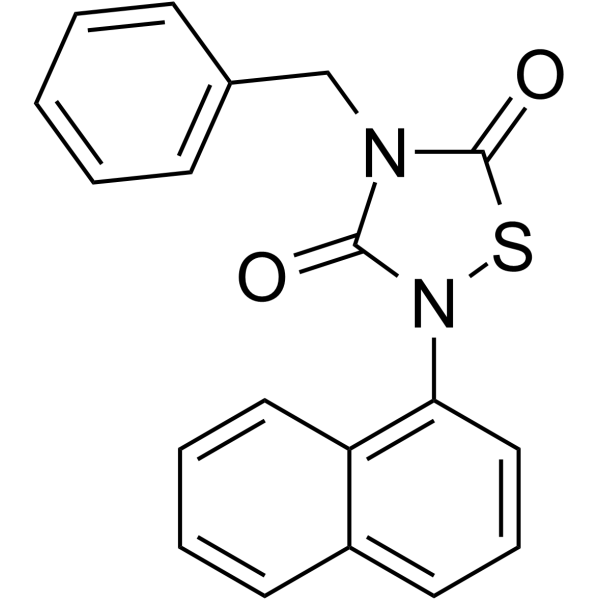Home
Products
Tideglusib



| Product Name | Tideglusib |
| Price: | Inquiry |
| Catalog No.: | CN00182 |
| CAS No.: | 865854-05-3 |
| Molecular Formula: | C19H14N2O2S |
| Molecular Weight: | 334.39 g/mol |
| Purity: | >=98% |
| Type of Compound: | Alkaloids |
| Physical Desc.: | Powder |
| Source: | |
| Solvent: | Chloroform, Dichloromethane, Ethyl Acetate, DMSO, Acetone, etc. |
| SMILES: | O=c1sn(c(=O)n1Cc1ccccc1)c1cccc2c1cccc2 |
| Contact us | |
|---|---|
| First Name: | |
| Last Name: | |
| E-mail: | |
| Question: | |
| Description | Tideglusib is an irreversible GSK-3 inhibitor with IC50s of 5 nM and 60 nM for GSK-3βWT (1 h preincubation) and GSK-3βC199A (1 h preincubation), respectively. |
| Target | GSK-3β(WT):5 nM (IC50) GSK-3β(C199A):60 nM (IC50) |
| In Vitro | Tideglusib (NP12) is a small heterocyclic thiadiazolidinone (TDZD) derivative, which is an ATP-non competitive inhibitor of GSK-3β with an IC50 value in the micromolar range[2]. Incubation of both astrocyte and microglial cultures with Tideglusib (NP031112) completely abrogates the induction of TNF-α and COX-2 expression after glutamate treatment. These effects of NP031112 are not caused by a loss of cell viability, because the 24 h exposure of astrocyte and microglial cells to this TDZD does not modify cell viability[3]. |
| In Vivo | Tideglusib (NP12) treatment correlates with an increase of 46% as an average in the inhibitory phosphorylation of GSK-3β at Ser-9 in the brains of APPsw-tauvlw mice, and the levels of the inactive from of the enzyme in NP12 treated mice are comparable to those found in wild-type littermate controls (p=0.893) (n=6-8 for each treatment). NP12 treatment results in significantly decreased phosphorylation at the putative GSK-3β-directed sites Ser-202 (CP13) and Ser-396/404 (PHF-1) in 15-month-old mice by more than 60% (p=0.023 and p=0.024, respectively)[2]. Injection of Tideglusib (NP031112) (50 mg/kg) into the rat hippocampus dramatically reduces kainic acid-induced inflammation, as measured by edema formation using T2-weighted magnetic resonance imaging and glial activation and has a neuroprotective effect in the damaged areas of the hippocampus[3]. |
| Animal Admin | Mice[2] Groups of APPsw-tauvlw mice are administered Tideglusib (n=10-11 for each age) or vehicle (n=10-11 for each age) starting at 9 months and 12 months of age during consecutive 3 months and used for subsequent clinicopathological analyses. Tideglusib is administered at a daily dose of 200 mg/kg. Groups of age and gender-matched wild-type littermate controls (n=10 for each age) receive vehicle alone on a similar timetable schedule. Rats[3] Adult male Wistar rats (8-12 weeks old) are used in this study. Rats (n≥5 per group) are anesthetized by intraperitoneal injection of ketamine (60 mg/kg) and Domtor (5 μg/kg) and placed into a stereotaxic apparatus. KA (1 μg in 2.5 μL PBS) alone or in combination with Tideglusib (2 ng in 2.5 μL PBS) is injected into the hippocampus. Control animals of the same age are injected with vehicle. |
| Density | 1.4±0.1 g/cm3 |
| Boiling Point | 511.3±43.0 °C at 760 mmHg |
| Flash Point | 263.0±28.2 °C |
| Exact Mass | 334.077606 |
| PSA | 72.24000 |
| LogP | 3.28 |
| Vapour Pressure | 0.0±1.3 mmHg at 25°C |
| Storage condition | 2-8°C |